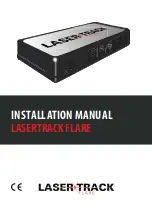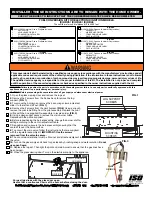
20
Before checking superheat run the unit in cooling for 10-15
minutes or until refrigerant pressues stabilize. Use the fol
-
lowing guidelines and methods to check unit operation and
ensure that the refrigerant charge is within limits.
For TXV systems, to adjust superheat, unscrew the cover
from the expansion valve, locate the adjustment screw, and
turn it clockwise (in) to increase superheat or counterclock
-
wise (out) to decrease superheat. It is recommended to
make small adjustments at a time, 1/8-1/4 turn increments.
Replace adjustment cap. Wait a minimum of 10 minutes
between adjustments to allow time for the TXV and pres
-
sures to stabilize.
Refrigerant Charge Check
NOTE: For optimal performance, follow charging instruc-
tions below.
(Units with Fixed Orifice Devices)
All package units with fixed orifice devices are charged using the
superheat method at the compressor suction line. To increase
super heat, remove charge and to decrease super heat, add
charge. After superheat is adjusted, it is recommended to check
unit subcooling at the condenser coil liquid line. See Design Su-
perheat and Subcooling table for targets on each model.
(Units with Expansion valve (TXV))
Single Stage Cooling Application: Refer to the Design Superheat
& Subcooling table
Two-Stage Cooling Application: Run unit on Low Stage cooling
and refer to Design Superheat & Subcooling table.
1. Purge gauge lines. Connect service guage manifold
to access fittings. Run system at least 10 minuets to
allow pressure to stabilize.
2. Temporarily install thermometer on liquid (small) line
near liquid line access fitting with adequate contact
and insulate for best possible reading.
3. Check subcooling and superheat. System should have
a subcooling and superheat within the range listed on
the Design Superheat and Subcooling table.
a. If subcooling and superheat are low, adjust TXV
superheat, then check subcooling.
NOTE:
To adjust superheat, turn the valve stem
clockwise to increase and counterclockwise to
decrease.
b. If subcooling is low and superheat is high, add charge
to raise subcooling then check superheat.
c. If subcooling and superheat are high, adjust TXV
valve superheat, then check subcooling.
d. If subcooling is high and superheat is low, adjust
TXV valve superheat and remove charge to lower
the subcooling.
NOTE:
Do NOT adjust the charge based on suction
pressure unless there is a gross undercharge.
4. Disconnect manifold set, installation is complete.
Model
Superhe
at
±2°F
Subcooli
ng
±1°F
Expansion
Device
Cooling
Stage
Outdoor
Ambient
(°F )
DP3GM24***41
7
-
Piston
high
95
DP3GM30***41
4
-
Piston
high
95
DP3GM36***41
5
-
Piston
high
95
DP3GM42***41
7
-
Piston
high
95
DP3GM48***41
15
-
Piston
high
95
DP3GM61***41
6
8
TXV
low
82
Design Superheat & Subcool
Cooling Operation
NOTE: Mechanical cooling cannot be reliably provided at
ambient temperatures below 50° F.
1. Turn on the electrical power supply to the unit.
2. Place the room thermostat selector switch in the
COOL position (or AUTO if available, and if automatic
changeover from cooling to heating is desired).
3. Set the room thermostat to the desired temperature.
TROUBLESHOOTING
Ignition Control Error Codes
The following presents probable causes of questionable
unit operation. Refer to
Diagnostic Indicator Chart
for
an interpretation of the signal and to this section for an
explanation.
Remove the control box access panel and note the
number of diagnostic LED flashes. Refer to
Diagnostic
Indicator Chart
for an interpretation of the signal and to
this section for an explanation.
Fault Recall (Two-Stage Models ONLY)
The ignition control is equipped with a momentary push-
button switch that can be used to display on the diagnostic
LED the last five faults detected by the control. The
control must be in Standby Mode (no thermostat inputs)
to use the feature. Depress the push-button switch for
approximately 2 seconds.
NOTE: Do not hold for longer
than 4 seconds. Holding the button for 4 seconds
or higher will erase the memory!
Release the switch
when the LED is turned off. The diagnostic LED will
then display the flash codes associated with the last five
detected faults. The order of display is the most recent
fault to the least recent fault.
Abnormal Operation - Heating
Internal Control Failure
If the integrated ignition control in this unit encounters an
internal fault, it will go into a “hard” lockout and turn off the
diagnostic LED. If diagnostic LED indicates an internal
fault, check power supply to unit for proper voltage, check
all fuses, circuit breakers and wiring. Disconnect electric
power for five seconds. If LED remains off after restoring
power, replace control.
External Lockout
An external lockout occurs if the integrated ignition
control determines that a measurable combustion cannot
















































